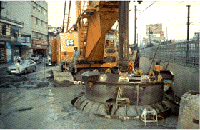
Bored Piles by Foundation Specialists, Inc.
Bored piles are cast in place cylindrical piles excavated either by use of rotary equipment operated augers , buckets, under static drilling fluid or large drill bit (for hard rock) with reverse circulation, with chisel grab and casing oscillator for bouldery ground, with large diameter DTH hammers and compressed air (drilled piles), among others.
Most common large diameter bored piles, are installed through an overburden of cohesive or cohesionless soil strata, with or without water tale, down to firmer ground, to achieve the design bearing capacity by skin friction, base bearing or both, to serve as foundation piles for residential, commercial, institutional buildings, industrial complexes or infrastructures.
Bored piles installed in common soil with the presence of water table, generally require the use of a short temporary steel casing and a drilling fluid as static suspension to provide support to the surrounding soil while excavating the pile and until complete backfill of the pile excavation with concrete, in order to prevent cave-in of the excavation and destabilizing the surrounding soil formation.
The preparation and handling by most effective drilling fluid, Bentonite Mud, is a sophisticated technology by itself and requires a complete set up of dedicated equipment and (basic) field laboratory.
The most common diameters of bored piles range from 0.6 meter to 2.0 m meters, likewise length can range from few meter to sixty or more meters, depending upon design loads and soil parameters.
Bored piles can be heavily reinforced if required by design, rebar cages usually are prefabricated in segments with length and weight depending upon available commercial lengths of rebars and available lifting equipment. Splicing of rebar cages can be done by lap splice, welded lap splice or mechanical threaded connectors. Casting is done by pouring concrete with the design strength and slump as required, through watertight segmental Tremie Pipes, starting from the pile bottom and letting the tremie pipe bottom end remain at least 3 meters submerged in concrete until the completion of pouring, to guarantee the pile continuity and the final good quality of the concrete cast.
Drilling fluids, if needed, can be water, a suspension of bentonite (bentonite mud), a suspension of polymers, depending upon soil type, soil conditions, presence and elevation of water table, chemical properties of water table (Ph, Salinity).
Steel casings can be temporary, in which case the wall thickness is usually big enough to allow many uses, are provided with collars for easy handling by vibro hammers and diameter slightly larger than bored piles’ nominal diameter, to allow easy passage of drilling tools. Permanent casings, if needed, are sacrificial casings and as such the wall thickness is as small as allowed by the need to drive the casing through the ground.
Bored piles are commonly employed for bridge foundations, on land and water, because the versatility of bored piles design and execution allows the construction of practically any needed diameter, including the very large diameters, and the pile reinforcement can be provided as heavy as needed by seismic design and the codes.
Bored piles are also used to form retaining walls, as contiguous piles wall or secant piles wall or aligned piles wall, with or without post tensioned soil anchors as tie back.
